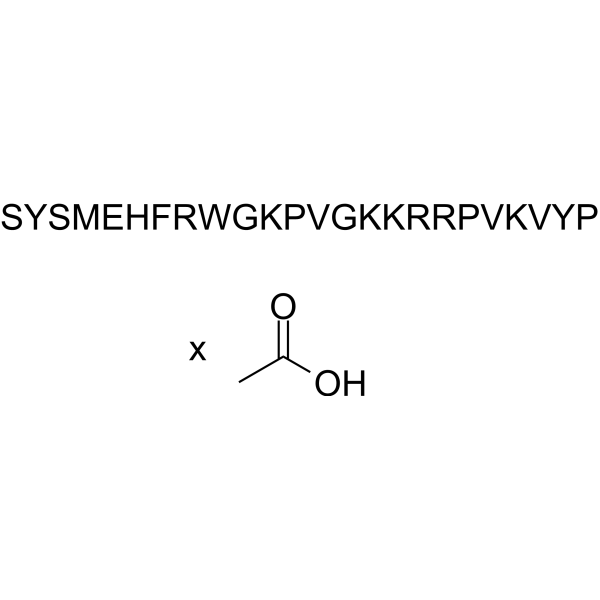
Tetracosactide acetate
CAS No. 60189-34-6
Tetracosactide acetate( Tetracosactrin acetate )
Catalog No. M28050 CAS No. 60189-34-6
Cosyntropin (acetate) stimulates the release of corticosteroids such as cortisol from the adrenal gland.
Purity : >98% (HPLC)
 COA
COA
 Datasheet
Datasheet
 HNMR
HNMR
 HPLC
HPLC
 MSDS
MSDS
 Handing Instructions
Handing Instructions
| Size | Price / USD | Stock | Quantity |
| 5MG | 177 | Get Quote |


|
| 10MG | 290 | Get Quote |


|
| 25MG | 492 | Get Quote |


|
| 50MG | 709 | Get Quote |


|
| 100MG | 972 | Get Quote |


|
| 200MG | Get Quote | Get Quote |


|
| 500MG | Get Quote | Get Quote |


|
| 1G | Get Quote | Get Quote |


|
Biological Information
-
Product NameTetracosactide acetate
-
NoteResearch use only, not for human use.
-
Brief DescriptionCosyntropin (acetate) stimulates the release of corticosteroids such as cortisol from the adrenal gland.
-
DescriptionCosyntropin (acetate) stimulates the release of corticosteroids such as cortisol from the adrenal gland.
-
In Vitro——
-
In Vivo——
-
SynonymsTetracosactrin acetate
-
PathwayOthers
-
TargetOther Targets
-
Recptor——
-
Research Area——
-
Indication——
Chemical Information
-
CAS Number60189-34-6
-
Formula Weight2993.5
-
Molecular FormulaC136H210N40O31S.XC2H4O2
-
Purity>98% (HPLC)
-
Solubility——
-
SMILESN/A
-
Chemical Name——
Shipping & Storage Information
-
Storage(-20℃)
-
ShippingWith Ice Pack
-
Stability≥ 2 years
Reference
1.Zhang M, et al. Improving the flame retardancy of poly(lactic acid) using an efficient ternary hybrid flame retardant by dual modification of graphene oxide with phenylphosphinic acid and nano MOFs. J Hazard Mater. 2020 Feb 15;384:121260.
molnova catalog



related products
-
2-Octenoic acid
2-Octenoic acid is a normal organic acid produced by hepatic microsomal oxidation of aliphatic aldehydes and is a metabolite naturally found in the urine and plasma.
-
4A3-SC8
4A3-SC8 is a modular dendritic macromolecule with cationic and lipophilic groups that enables small RNAs to prolong survival in an aggressive hepatocellular carcinoma model and can be used to synthesize lipid nanoparticles.
-
GR103545
(R)-(-)-GR103545 fumarate is a chemical compound.



 Cart
Cart
 sales@molnova.com
sales@molnova.com


